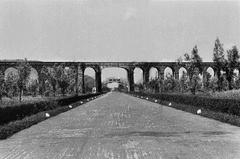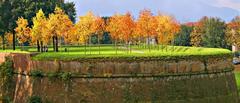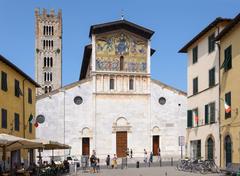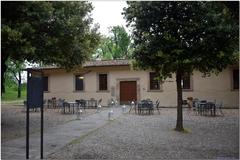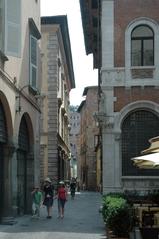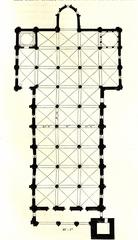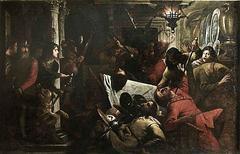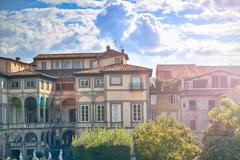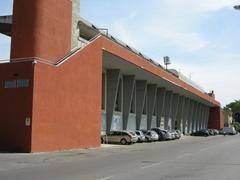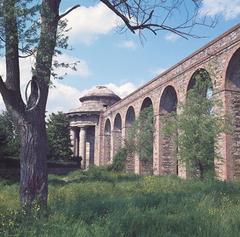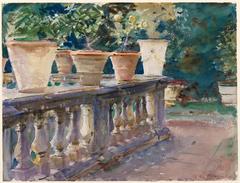Exploring Lucca’s Via delle Mura Urbane: History, Significance, and Visitor Information
Date: 18/07/2024
Introduction
Table of Contents
- Introduction
- Historical Evolution and Significance
- Significance of Via della Mura Urbane
- Visitor Information
- Architectural Features of Lucca’s Walls
- Key Entrances to the Walls
- Exploring the Walls - Tips for a Memorable Visit
- Conclusion
Historical Evolution and Significance
Roman Origins and Medieval Fortifications
The story of Lucca’s walls begins in the Roman era. Founded in 180 BC as a Roman colony, Lucca (then Luca) was a strategically important settlement. While the exact date of the first walls is debated, historians believe the Romans enclosed the city with defensive walls, likely built using square-cut stone blocks without mortar.
During the medieval period, as Lucca grew in importance and faced various threats, the city walls were reinforced and expanded. Between the 10th and 13th centuries, the walls underwent significant modifications, reflecting the evolving military architecture of the time. Towers were added, and the walls were heightened to withstand siege weaponry.
The Renaissance and the Transformation into a Public Promenade
The Renaissance brought a period of relative peace and prosperity to Lucca. With the decreased need for defensive fortifications, the city walls underwent a remarkable transformation. In the 16th century, renowned engineer Alessandro Farnese oversaw a project to modernize the walls, adapting them to withstand artillery attacks. However, the focus shifted from purely defensive structures to a more integrated part of the city.
The top of the walls, once reserved for guards and soldiers, was gradually transformed into a public promenade. Trees were planted, and benches were added, creating a green belt encircling the historic center. This transformation reflected the changing role of the walls, from a symbol of military might to a cherished public space for leisure and recreation.
The Walls Today - A Living Monument
Today, Le Mura di Lucca stand as a magnificent example of Renaissance military architecture and a beloved landmark. The 4.2 kilometers (2.6 miles) of tree-lined ramparts offer breathtaking panoramic views of the city and the surrounding countryside. The walls have become an integral part of Lucca’s identity, a place for locals and tourists alike to stroll, cycle, picnic, and enjoy the unique atmosphere.
Significance of Via della Mura Urbane
Via della Mura Urbane, the road atop the walls, holds immense significance for Lucca. It represents a fascinating blend of history, urban planning, and social life, embodying the city’s evolution over centuries.
A Symbol of Preservation and Continuity
The very existence of Via della Mura Urbane is a testament to Lucca’s commitment to preserving its heritage. While other cities dismantled their walls, Lucca chose to integrate them into the fabric of urban life. This decision has not only preserved a remarkable historical monument but has also created a unique and beloved public space.
A Green Lung and Recreational Haven
Via della Mura Urbane serves as a “green lung” for the city, offering a welcome respite from the bustling streets below. The tree-lined promenade provides shade and tranquility, making it an ideal place for leisurely walks, bike rides, and picnics. The presence of this green space within the city walls contributes significantly to Lucca’s quality of life.
A Social Hub and Gathering Place
Beyond its historical and environmental significance, Via della Mura Urbane is a vibrant social hub. Locals and tourists alike gather here to socialize, exercise, and enjoy the views. The walls host various events throughout the year, from concerts and markets to historical reenactments, further solidifying their role as a central gathering place for the community.
A Unique Perspective on Lucca
Walking or cycling along Via della Mura Urbane offers a unique perspective on Lucca. From the elevated vantage point, visitors can appreciate the city’s layout, admire the Renaissance architecture, and enjoy panoramic views of the surrounding landscape. This distinct perspective provides a deeper understanding of Lucca’s urban fabric and its relationship with the surrounding countryside.
Visitor Information
Visiting Hours and Tickets
The walls are accessible 24/7, but the best time to visit is during daylight hours to fully appreciate the views. There is no admission fee to walk along the walls, making it a budget-friendly activity for all visitors.
Travel Tips and Accessibility
- Getting There: Lucca is easily accessible by train from major cities like Florence and Pisa. The train station is a short walk from the city walls.
- Accessibility: The walls are accessible to pedestrians, cyclists, and those with mobility issues. Ramps and smooth pathways make it easy for everyone to enjoy.
Nearby Attractions
- Piazza dell’Anfiteatro: A historic square built on the site of a Roman amphitheater.
- Lucca Cathedral: Known for its stunning façade and impressive interiors.
- Guinigi Tower: Famous for its rooftop garden and panoramic views.
Special Events and Guided Tours
The walls host various events throughout the year, including concerts, markets, and historical reenactments. Guided tours are available for those interested in a deeper dive into Lucca’s history. Check the official Lucca tourism website for up-to-date information on events and tours.
Photographic Spots
The walls offer numerous spots perfect for photography, especially during sunrise or sunset. Key spots include the bastions and gates, which provide excellent backdrops for memorable photos.
Architectural Features of Lucca’s Walls
The Renaissance Design
Unlike many medieval walls that were simply defensive structures, Lucca’s walls were designed with aesthetics in mind. This is largely thanks to the influence of Flemish engineer Jacopo Seghettini, who, in the 16th century, spearheaded the modernization project. He envisioned a structure that was not only impenetrable but also beautiful, blending seamlessly with the surrounding landscape.
Bastions - Strategic Defensive Points
The walls are punctuated by eleven imposing bastions, each strategically placed to provide overlapping fields of fire. These bulwarks, added in the 16th century, were designed to withstand cannon fire and provided elevated platforms for artillery.
- Bastion San Martino: One of the most prominent, this bastion offers panoramic views of the city and the surrounding countryside.
- Bastion Santa Croce: Located near the train station, this bastion houses a playground, making it a popular spot for families.
Ramparts and Casemates - Sheltering Soldiers and Artillery
The wide, sloping ramparts atop the walls were designed to allow soldiers to move quickly and easily. Beneath the ramparts, a series of vaulted chambers known as casemates provided shelter for troops and ammunition, further enhancing the defensive capabilities of the walls.
Gates - Grand Entrances to the City
Six monumental gates pierce the walls, each a masterpiece of Renaissance architecture, serving as grand entrances to the city.
- Porta San Pietro: This gate, facing north, was the main entrance to the city from Florence. Its imposing facade features the Medici coat of arms, a reminder of Florence’s historical influence over Lucca.
- Porta Santa Maria: Facing west, this gate welcomed travelers arriving from the sea and Via Francigena, an ancient pilgrimage route. Its elaborate decorations include a statue of the Madonna and Child.
- Porta San Donato: This gate, facing east, was the main entrance from Pisa and Rome. It is known for its simplicity and elegance.
- Porta Elisa: The newest of the gates, built in the early 19th century, honors Elisa Bonaparte, Napoleon’s sister, who briefly ruled Lucca. Its neoclassical style contrasts with the Renaissance architecture of the other gates.
Hidden in Plain Sight - The Aqueduct
An often-overlooked feature is the aqueduct that runs alongside a portion of the walls. Built in the 19th century, it carried water from the nearby hills to the city center, demonstrating the city’s ingenuity in combining practicality with aesthetics.
Key Entrances to the Walls
Accessing the top of Lucca’s walls is easy, with multiple points of entry distributed around the perimeter.
Ramps and Stairways - Easy Access for All
- Near Porta San Pietro: A gentle ramp near this gate provides easy access for strollers and wheelchairs.
- Near Porta Santa Maria: A staircase near this gate leads directly to the top of the walls.
- Near Porta Elisa: Another ramp near this gate offers a gradual ascent to the wall-top pathway.
Elevators - Modern Convenience
For those who prefer a more modern mode of ascent, elevators provide access to the walls at two locations:
- Panoramic Elevator at Bastion San Regolo: Located near the Guinigi Tower, this elevator offers stunning views as you ascend.
- Elevator at Bastion Santa Maria: This elevator, near the Piazza Santa Maria, provides easy access for those with mobility issues.
Exploring the Walls - Tips for a Memorable Visit
- Walk or Bike: The best way to experience the walls is on foot or by bike. The entire circuit is approximately 4 kilometers (2.5 miles) long and offers stunning views of the city and the surrounding countryside.
- Allow Ample Time: Allow at least two hours to fully appreciate the walls, stopping to admire the bastions, gates, and views.
- Pack a Picnic: The walls provide a perfect setting for a leisurely picnic lunch or a romantic evening stroll.
- Visit at Sunset: The walls offer breathtaking views of the sunset over the Tuscan hills.
- Attend Events: Throughout the year, the walls host various events, including concerts, markets, and historical reenactments.
